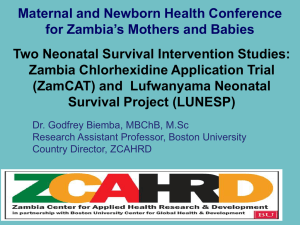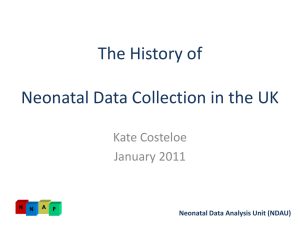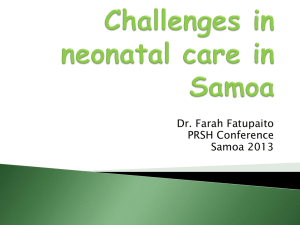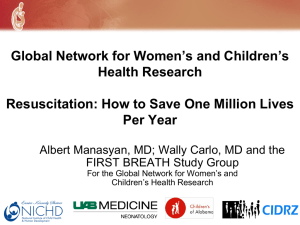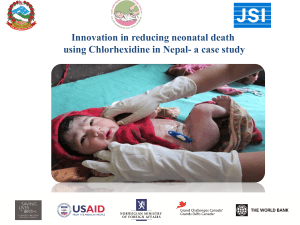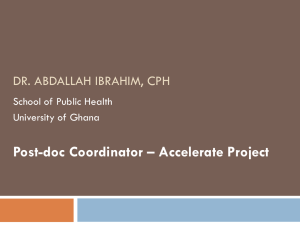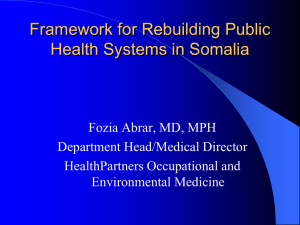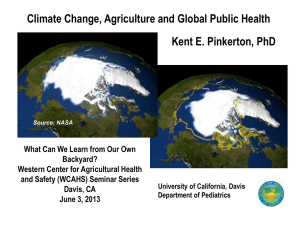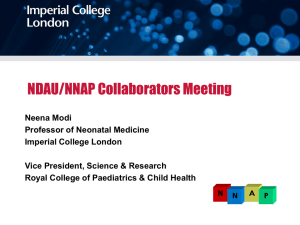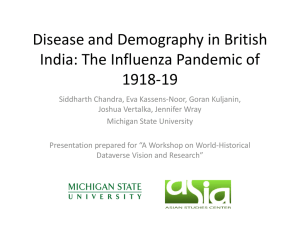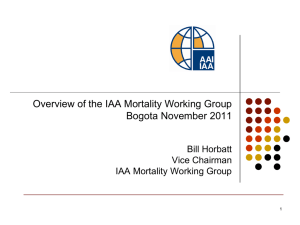Addressing the Challenge of Neonatal Mortality
advertisement
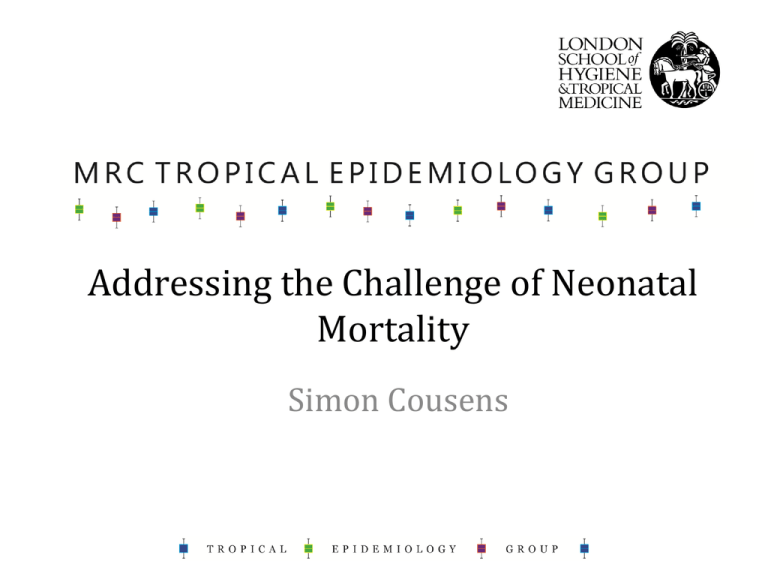
Addressing the Challenge of Neonatal Mortality Simon Cousens Millennium Development Goal 4 Reduce by two-thirds, between 1990 and 2015, the under 5 mortality rate 0 25 29 50 75 100 Millennium Development Goal 4 1990 1995 2000 2005 2010 2015 Year Source: Levels and trends in Child Mortality. Report 2011. Estimates developed by the Inter-agency Group for Mortality Estimation. 29 50 0 25 Mortality rate 75 100 Millennium Development Goal 4 1990 1995 2000 2005 2010 2015 Year U5MR NMR Sources: Levels and trends in Child Mortality. Report 2011. Estimates developed by the Inter-agency Group for Mortality Estimation. Oestergaard et al. PLoS Med. 2011 8:e1001080 Geographical distribution of neonatal mortality in 2009 Region NMR % of neonatal deaths High income 3.6 1.4% sub-Saharan Africa 35.9 34% South East Asia 30.7 36% Source: Oestergaard et al. PLoS Med. 2011 8:e1001080 0 10 20 30 40 Neonatal mortality rates in England and Wales 1920 1940 1960 Year Early neonatal mortality 1980 2000 Late neonatal mortality Source: ONS mortality statistics (www.statistics.gov.uk) Community-based care: a seminal paper from India Bang et al. Lancet 1999. 354: 1955-1961 Implemented a home care package in a rural setting with high NMR Trained village health workers to perform home visits, to promote breastfeeding and thermal management, in simple techniques to manage birth asphyxia, and to treat infections Community-based care: a seminal paper from India Treatment of sepsis Source: Bang et al. Lancet 1999. 354: 1955-1961 c. 60% reduction in NMR The Lancet Neonatal Survival Series (2005) Editors: JE Lawn and S Cousens Developed a model to estimate how many neonatal deaths could be prevented by increasing coverage of a package of relatively simple, cost-effective interventions Estimated that 36-67% of neonatal deaths in 75 high mortality countries could be averted by high coverage (90%) with 16 interventions Only about half of this reduction was through community-based care Source: Lancet 2005. 365:977-988 Lives Saved Tool (LiST) Freely available software tool for programme planners http://www.futuresinstitute. org/pages/Spectrum.aspx Two recent studies: The Hala Trial, Pakistan Lancet 2011. 377: 403-412 The Hala Trial, Pakistan Intervention: Lady Health Workers (LHWs) trained in preventive newborn care Dais (TBAs) trained in basic newborn care Communities encouraged to establish Community Health Committees 16 clusters randomised: Approximately 23,000 live births identified over a 30 month period Primary outcome: all-cause neonatal mortality Lancet 2011. 377: 403-412 The Hala Trial, Pakistan NMR Intervention clusters Control clusters Risk ratio (95% c.i.) 43.0 49.1 0.85 (0.76, 0.96) P=0.02 Trial differed from other community-based trials in region in that intervention principally delivered through government health system rather than workers employed by research team. lower intervention coverage than has been reported in other trials smaller mortality impact Despite limitations, encouraging that public sector programme promoting preventive care can produce health benefits Cord care WHO recommends dry cord care BUT in a Cochrane review from 2004 all 21 trials were conducted in hospitals all but one in high income settings no systemic infections or deaths in any of the trials Source: Zupan et al. Cohrane Database Syst Rev 2004. 3: CD001057 Cord care A subsequent community-based trial of topical chlorhexidine in Nepal reported: a 75% reduction in severe omphalitis a 24% reduction in neonatal mortality compared with dry cord care Source: Mullany et al. Lancet 2006. 367:910-918 Chlorhexidine trial, Pakistan Lancet 2012. 379:1029-1036 Chlorhexidine trial, Pakistan 187 clusters randomly allocated in 2x2 factorial design 2 interventions Chlorhexidine (daily for 2 weeks) vs dry cord care Handwashing promotion vs no handwashing promotion Interventions delivered through Dais Facility births excluded 9741 livebirths enrolled over 18 months Chlorhexidine trial, Pakistan Neonatal mortality Neonatal deaths (NMR) Risk ratio (95% c.i.) No handwashing promotion 147 (29.1) 1.0 Handwashing promotion 140 (29.9) 1.08 (0.79, 1.48) Dry cord care 176 (36.1) 1.0 Chlorhexidine 111 (22.8) 0.62 (0.45, 0.85) P 0.62 0.003 Chlorhexidine “We could argue that more research is needed— questions certainly exist about the duration and timing of application and about external validity. Evidence from high-mortality populations in Africa would be useful. Nevertheless, to demand more evidence of effectiveness might be to repeat an old public health debate: if the need is clear, the possibilities attractive, and the risk low, how much evidence is necessary before we act on plausible findings?” Osrin and Hill. Commentary. Lancet 2012. 379:984-986. The challenge of neonatal mortality: what needs to be done? Effective interventions are available: how do we make sure they reach mother’s and newborns? Improve the quality and quantity of data available to: assist rational policy making Monitor progress Acknowledgements Joy Lawn, Zulfiqar Bhutta, Gary Darmstadt, Hannah Blencowe, Susana Scott, Neff Walker, Mikkel Oestergaard, Colin Mathers and many others
